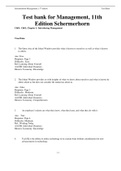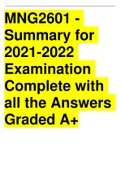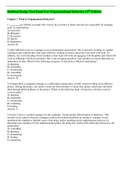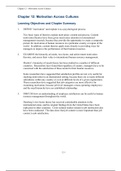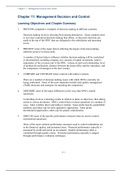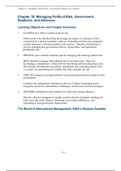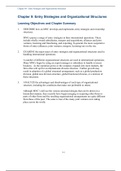Boston University School Of Management
Latest uploads at Boston University School Of Management. Looking for notes at Boston University School Of Management? We have lots of notes, study guides and study notes available for your school.
-
16
- 0
-
1
All courses for Boston University School Of Management
- Chapter 10: Managing Political Risk, Government 1
- Chapter 11 Management Decision and Control 1
- Chapter 12: Motivation Across Cultures 1
- Chapter 3: Ethics and Social Responsibility 2
- Chapter 4: The Meanings and Dimensions of Culture 1
- Chapter 6: Organizational Cultures and Diversity 1
- Chapter 7: Cross-Cultural Communication and Negotiation 1
- Chapter 8: Strategy Formulation and Implementation 1
- Chapter 9: Entry Strategies and Organizational Structures 1
Latest notes & summaries Boston University School Of Management
QUESTION 1 [3 MARKS] Explain the difference between a value chain and a supply chain. Provide specific examples from the operations of Toyota South Africa to illustrate the difference. In your answer, you should demonstrate a critical understanding of the interrelated activities involved in each chain and how they contribute to the creation and delivery of value to customers. QUESTION 2 [10 MARKS] As an expert in supply chain risk management, you have been tasked by Toyota South Africa to aid th...
Test bank for Management, 11th Edition Schermerhorn Ch01: Ch01, Chapter 1: Introducing Management True/False 1. The Open Area of the Johari Window provides what is known to ourselves as well as what is known to others. Ans: True Response: Page 3 Difficulty: Easy Ref: Learning About Yourself AACSB: Individual Dynamics Bloom's Taxonomy: Knowledge 2. The Johari Window provides us with insights of what we know about ourselves and what is known by others about us but does not consider t...
Question 5 of 14 1.0 Points Office managers perform the following functions of management: . (Multiple correct answers) A. motivating B. controlling C. leading D. coordinating E. delegating F. organising G. planning Answer Key:B, C, F, G Feedback: Direct theory question. Correct answer: planning organising control leading Reference in prescribed book and Learning outcome (LO): p. 31 LO2 Question 6 of 14 1.0 Points The managerial skill "teambuilding" includes coaching...
Robbins/Judge Test Bank For Organizational Behavior 15th Edition Chapter 1 What Is Organizational Behavior? 1) are defined as people who oversee the activities of others and who are responsible for attaining goals in organizations. A) Assistants B) Managers C) Secretaries D) Interns E) Apprentices Answer: B 2) Sally Mitchell works as a manager at an environmental organization. She is currently working on a global warming project and decides what tasks related to creating awareness ...
AD 685 Project – Spring 2023 Instructions: Please complete the guided project by May 10, 11:59 PM (EST). Write your answer below each question and upload a “word doc” named LastName_FirstN using the link on Blackboard. Also, upload the work file from Eviews (LastName_FirstN). This work file should have two “tabs” one for Part 1 and one for Part 2. Excel is not suitable for this project and it will not be accepted. This project consist of two parts: Part 1:...
A nurse is a receiving report on four clients. Which of the following clients should the nurse assess first? a) A client who has illeal conduit and mucus in the pouch b) Client pleasant arteriovenous additional vibration palpated c) A client whose chronic kidney disease with cloudy diasylate outflow d) A client was transurethral resection of the prostate with a red tinged urine in the bag 8) A nurse is caring for a client just received the first dose of lisinopril. The following is an appro...
Chapter 12: Motivation Across Cultures Learning Objectives and Chapter Summary 1. DEFINE "motivation" and explain it as a psychological process. Two basic types of theories explain motivation: content and process. Content motivation theories have been given much more attention in international management research, because they provide the opportunity to create a composite picture for motivation of human resources in a particular country or region of the world. In addition, content th...
Chapter 11: Management Decision and Control Learning Objectives and Chapter Summary 1. PROVIDE comparative examples of decision-making in different countries. Decision-making involves choosing from among alternatives. Some countries tend to use more centralized decision-making than others, so that more decisions are made at the top of the MNC than are delegated to the subsidiaries and operating levels. 2. PRESENT some of the major factors affecting the degree of decision-making au...
Chapter 10: Managing Political Risk, Government Relations, and Alliances Learning Objectives and Chapter Summary 1. EXAMINE how MNCs evaluate political risk. Political risk is the likelihood that the foreign investment of a business will be constrained by a host government’s policies. In dealing with this risk, companies conduct both macro and micro political risk analyses. Specific consideration is given to changing host government policies, expropriation, and operational profitabi...
Chapter 9: Entry Strategies and Organizational Structures Learning Objectives and Chapter Summary 1. DESCRIBE how an MNC develops and implements entry strategies and ownership structures. MNCs pursue a range of entry strategies in their international operations. These include wholly owned subsidiaries, mergers and acquisitions, alliances and joint ventures, licensing and franchising, and exporting. In general, the more cooperative forms of entry (alliances, joint ventures, mergers, lice...


